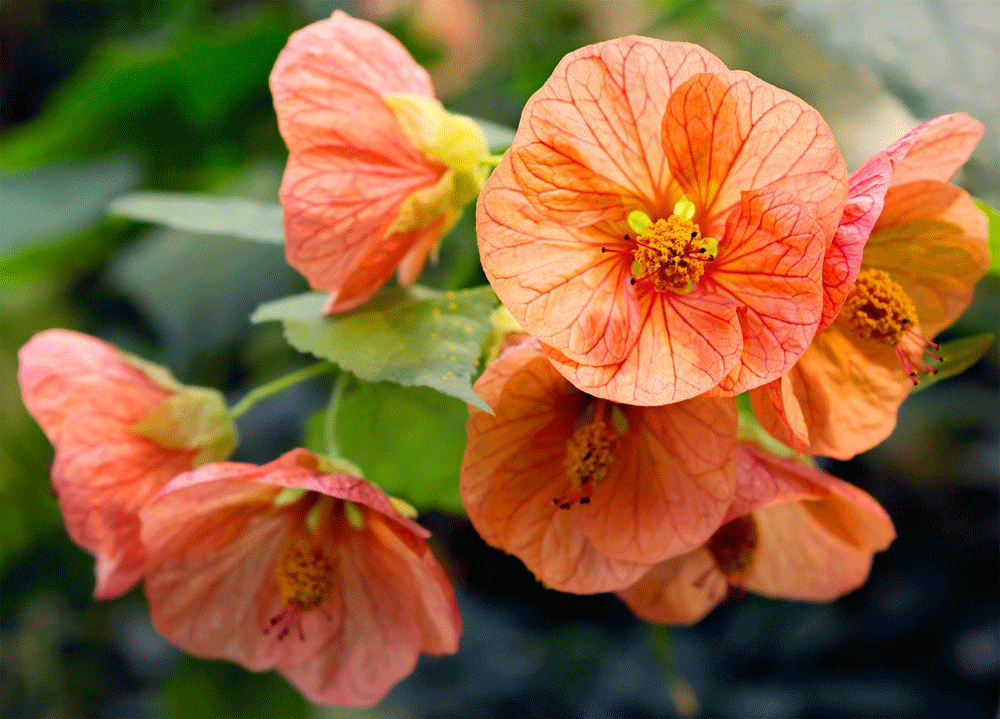Abutilon is called flowering maple because of the shape of its broad, five-lobed leaves, but it is in no way a maple. It is more closely related to the hollyhock and to the weed known as velvet leaf. When given good light and proper care, abutilon rewards its keeper by producing papery blossoms on drooping stems nearly year-round. Flowers may be red, yellow, pink, orange, or peach, depending on variety. Some varieties feature leaves mottled with yellow, but the strongest growers have solid green leaves. Abutilon plants tend toward legginess, so it is important to prune them back by one-third their size in the spring, just before the most vigorous flush of new growth begins. Also pinch back stems occasionally through the summer to promote a full, bushy shape. Regular pruning makes it easy to keep an abutilon less than 18 in/45 cm high and wide. If you want an upright plant to 36 in/1 m tall, tie long branches to sturdy stakes.
SPECIFICATIONS
Light: Bright indirect light from a south or west window.
Temperature: Average room temperatures (65–75°F/18–24°C) year-round.
Fertilizer: From spring through fall, feed every 2 weeks with a balanced houseplant fertilizer. In winter, feed monthly, as plants grow more slowly.
Water: Water thoroughly and then allow plants to dry until the top inch of soil feels dry to the touch before watering again. Mist every few days in winter to prevent problems with spider mites when the air is very dry.
Soil: Any peaty potting soil; never add lime, as abutilon likes acidic soil conditions.
Repotting: Repot young plants every 6 months or so to accommodate growing roots. After plants fill an 8 in/20 cm pot, usually when they are 3 years old, propagate new plants from stem tip cuttings and discard the parent plant.
Longevity: Plants become woody and unattractive by the time they are 3 or 4 years old, but can be kept indefinitely by propagating stem tip cuttings.
Propagation: Take 4 in/10 cm-long stem tip cuttings in spring or summer and set them to root in damp seed-starting mix as described on page 299. Use rooting powder. Transplant to potting soil after 4 to 6 weeks, setting three rooted cuttings in a 6 in/15 cm container.
Selections: Abutilon has been extensively hybridized, so there are dozens of named cultivars. Those with mottled or variegated foliage are best grown as foliage plants, because they tend to be weak bloomers.
Display tips: In addition to being grown in pots or hanging baskets, abutilon can be trained to assume a treelike shape by tying the main stem to a sturdy stake and pinching off all branches that emerge from the lowest 15 in/38 cm of stem.
TROUBLESHOOTING
Plant does not bloom.
Cause: Not enough light, or needs additional fertilizer.
Remedy: Move plant to a place where it will get bright natural light half the day. Switch to a high-phosphorous fertilizer. Some plants bloom very little in winter, but vigorous hybrids should bloom year-round with good light and regular feeding.
Flowers and low leaves drop.
Cause: Uneven watering, resulting in some roots remaining dry; too much direct sun.
Remedy: Rehydrate pot as described on page 328. In summer, move plant to a place where it will be protected from hot midday and afternoon sun.
Sticky leaves; small insects present on leaves.
Cause: Aphids.
Remedy: Prune plant to remove badly infested leaves. Clean thoroughly with plenty of water every 3 days for 2 weeks. See page 269 for more information on controlling this pest.
Leaves are pale and stippled with yellow dots; faint webbing on leaf undersides.
Cause: Spider mites.
Remedy: Isolate plant, and prune off and dispose of badly infested leaves. Clean undersides of remaining leaves with warm, soapy water. Mist daily for a week and see if plant shows signs of recovery. If plant has a stem that is not infested, attempt to propagate its tip, because seriously damaged plants may not be worth saving.


